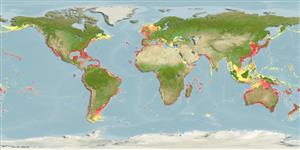Classificação / Names
Common names from other countries
Referência principal
Tamanho / Peso / Idade
Max length : 100.0 cm SL macho/indeterminado; (Ref. 2804); common length : 50.0 cm SL macho/indeterminado; (Ref. 7399); Idade máx. registada: 16 anos (Ref. 28725)
Length at first maturity
Lm 35.4, range 30 - ? cm
Ambiente
; marinhas; Água doce; estuarina bentopelágico; catádromo (Ref. 51243); intervalo de profundidade 0 - 120 m (Ref. 9321), usually 0 - 10 m
Clima / Intervalo
Subtropical; 8°C - 24°C (Ref. 4944), preferred 26°C (Ref. 107945); 62°N - 57°S, 180°W - 180°E (Ref. 54241)
Distribuição
Cosmopolitan in coastal waters of the tropical, subtropical and temperate zones of all seas. Eastern Pacific: California, USA to Chile (Ref. 2850). Western Pacific: Japan to Australia (Ref. 9812). Western Indian Ocean: from India to South Africa (Ref. 4393). Western Atlantic: Nova Scotia, Canada to Brazil (Ref. 7251); Cape Cod to southern Gulf of Mexico (Ref. 26938); absent in the Bahamas and most of West Indies and Caribbean (Ref. 7251, 9761). Eastern Atlantic: Bay of Biscay to South Africa, including the Mediterranean Sea and Black Sea (Ref. 7399). Reported in Sea of Okhotsk (Ref. 50550).
Países | Áreas FAO | Ecossistemas | Ocorrências | Introduções
Descrição breve
Espinhos dorsais (total): 5; Raios dorsais moles (total): 7-9; Espinhos anais 3; Raios anais moles: 8 - 9. Diagnosis: body stout, cylindrical in cross-section, slightly compressed; head broad and flattened (Ref. 57400). Well developed adipose eyelid (Ref. 40476, 57400) covering most of pupil (Ref. 57400). Upper lip thin and without papillae, armed with 1-6 rows of fine teeth; hind end of upper jaw reaching a vertical line from anterior eye margin; maxillary pad not visible below corner of mouth when closed; origin of 1st dorsal fin nearer to snout tip than to caudal-fin base; anterior parts and bases of 2nd dorsal and anal fins with a moderately dense coverage of scales; pectoral axillary process; 14-15 scale rows between origins of dorsal and pelvic fins (Ref. 57400).
Categoria na Lista Vermelha da IUCN (Ref. 115185)
Utilização humana
Pescarias: altamente comercial; Aquacultura: espécies comerciais; peixe desportivo: sim; isco: occasionally
Ferramentas
Relatórios especiais
Descarregue XML
Fontes da internet
Estimates of some properties based on models
Phylogenetic diversity index
PD50 = 0.5000 many relatives (e.g. carps) 0.5 - 2.0 few relatives (e.g. lungfishes)
Nível Trófico
2.5 ±0.17 se; Based on food items.
Resiliência
Médio, tempo mínimo de duplicação da população 1,4 - 4,4 anos (K=0.09-0.15; tm=2-6; tmax=16; Fec=1.6 million)
Vulnerabilidade
Moderate to high vulnerability (50 of 100)
Categoria de preço
